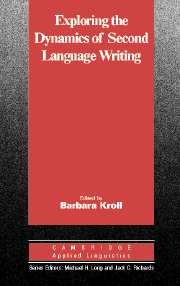Book contents
- Frontmatter
- Contents
- List of contributors
- Acknowledgments
- List of abbreviations used
- Series editors' preface
- Introduction: Teaching the next generation of second language writers
- I EXPLORING THE FIELD OF SECOND LANGUAGE WRITING
- II EXPLORING THE VOICES OF KEY STAKEHOLDERS:TEACHERS AND STUDENTS
- III EXPLORING WRITERS' FINISHED TEXTS
- IV EXPLORING CONTEXTUALITIES OF TEXTS
- Chapter 8 Genre and ESL/EFL composition instruction
- Chapter 9 Changing currents in contrastive rhetoric: Implications for teaching and research
- Chapter 10 Reading and writing relations: Second language perspectives on research and practice
- Chapter 11 Literature in the teaching of second language composition
- V EXPLORING TECHNOLOGY
- EPILOGUE: EXPLORING OURSELVES
- Index
Chapter 10 - Reading and writing relations: Second language perspectives on research and practice
Published online by Cambridge University Press: 05 October 2012
- Frontmatter
- Contents
- List of contributors
- Acknowledgments
- List of abbreviations used
- Series editors' preface
- Introduction: Teaching the next generation of second language writers
- I EXPLORING THE FIELD OF SECOND LANGUAGE WRITING
- II EXPLORING THE VOICES OF KEY STAKEHOLDERS:TEACHERS AND STUDENTS
- III EXPLORING WRITERS' FINISHED TEXTS
- IV EXPLORING CONTEXTUALITIES OF TEXTS
- Chapter 8 Genre and ESL/EFL composition instruction
- Chapter 9 Changing currents in contrastive rhetoric: Implications for teaching and research
- Chapter 10 Reading and writing relations: Second language perspectives on research and practice
- Chapter 11 Literature in the teaching of second language composition
- V EXPLORING TECHNOLOGY
- EPILOGUE: EXPLORING OURSELVES
- Index
Summary
In the past two decades, the role of reading-writing relationships has been a topic of increasing interest to both reading and writing specialists. Researchers from a variety of fields (e.g., education, composition, reading, learning psychology, and applied linguistics) have become interested in the ways that reading and writing might reinforce or accelerate the learning of content, the development of literacy skills, and the acquisition of language abilities. Interaction between reading and writing is thus a topic of concern in the academy as it relates to students studying in their first language (L1) as well as students studying in their second language (L2). Writing teachers in particular need to understand what has been learned through a variety of research studies on a range of topics related to the multiple ways in which reading and writing interconnect so that these teachers can develop a broad-based view to help them guide student learning.
In L1 contexts, a number of seminal studies on reading-writing relations appeared in the 1980s. In these studies, researchers examined correlations between learners' reading and writing abilities, the roles of author and audience in reading and writing contexts, and the ways in which students improve their learning by reading and writing together. By 1990, there was a solid body of research on these topics in L1 contexts that allowed researchers to ask more probing questions and extend the earlier work, and this range of research has continued into this century.
Information
- Type
- Chapter
- Information
- Exploring the Dynamics of Second Language Writing , pp. 242 - 262Publisher: Cambridge University PressPrint publication year: 2003
Accessibility standard: Unknown
Why this information is here
This section outlines the accessibility features of this content - including support for screen readers, full keyboard navigation and high-contrast display options. This may not be relevant for you.Accessibility Information
- 37
- Cited by
